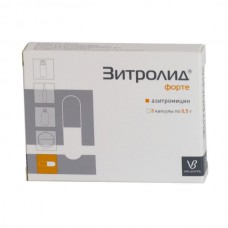Expiration date: 02/2026
The composition and form of issue:
Capsules. 1 capsule contains:
azithromycin (in terms of active substance) 0, 5 g
excipients: MCC magnesium stearate - to obtain the mass of the contents of the capsule 0, 57 g
hard gelatin capsule: gelatin titanium dioxide yellow dye "sunset"
in a polymer bottle or contour acheikova packing 3 or 6 PCs. in cardboard pack 1 jar or package.
Description of dosage form:
3 capsules with a white body and an orange cap.
The contents of capsules powder from white to white with a yellowish hue.
Pharmacological action:
Bacteriostatic, in high concentrations — bactericidal.
Pharmacokinetics:
After ingestion, it is rapidly absorbed from the digestive tract, due to resistance in an acidic environment and lipophilicity. After intake of 500 mg Cmax in plasma achieved through 2, 5-2, 96 h and is 0, 4 mg/l. Bioavailability is 37%.
It penetrates well into the respiratory tract, organs and tissues of the urogenital tract (including the prostate gland), into the skin and soft tissues. It creates high concentrations in tissues (10-50 times higher than its content in plasma) and has a long T1/2, due to the low binding of azithromycin with plasma proteins, as well as its ability to penetrate into eukaryotic cells and concentrate in a low pH environment surrounding lysosomes. It has a large apparent volume of distribution (31, 1 l/kg) and a high plasma clearance.
Demetiliruetsa in the liver with formation of inactive metabolites.
The removal of azithromycin from blood plasma takes place in 2 stages: T1/2 is 14-20 h in the range of 8-24 h after taking the drug and 41 h — in the range of 24-72 h, which allows you to take the drug 1 time per day.
Description of the pharmacological action:
Broad-spectrum antibiotic, representative of the subgroup of macrolide antibiotics — azalides. When creating in the focus of inflammation of high concentrations has a bactericidal effect. Active against gram-positive cocci (Streptococcus pneumoniae, Str. pyogenes, Str. agalactiae, streptococci of groups C, F and G, Staphylococcus aureus, Str. viridans), gram-negative bacteria (H. influenzae, M. catarrhalis, B. pertussis, B. parapertussis, L. pneumophila, H. ducreyi, C. jejuni, H. pylori, N. gonorrhoeae, G. vaginalis), some anaerobic microorganisms: B. bivius, C. perfringens, Peptostreptococcus spp. and C. trachomatis, M. pneumoniae, U. class, T. pallidum and B. burgdorferi. Azithromycin is inactive against gram-positive bacteria resistant to erythromycin.
The ability of azithromycin to accumulate mainly in lysosomes is especially important for the elimination of intracellular pathogens. The phagocytes deliver azithromycin to the places of infection, where it is released in the process of phagocytosis. The concentration of azithromycin in the foci of infection is higher than in healthy tissues (on average 24-34%) and correlates with the degree of inflammatory edema. Despite the high concentration in phagocytes, azithromycin has no significant effect on their function. Azithromycin is preserved in bactericidal concentrations in the focus of inflammation within 5-7 days after taking the last dose, which allowed to develop a short (three - and five-day) course of treatment.
Indications:
Infectious and inflammatory diseases caused by microorganisms sensitive to the drug:
- infections of the upper respiratory tract and ENT organs (angina, sinusitis, pharyngitis, tonsillitis, otitis media)
- infections of the lower respiratory tract (bacterial and atypical pneumonia, bronchitis)
- scarlatina
- infections of the skin and soft tissues (erysipelas, impetigo, secondary infected dermatoses)
- urogenital tract infections (uncomplicated urethritis and/or cervicitis)
- Lyme disease (borreliosis) - for the treatment of the initial stage (erythema migrans)
- diseases of the stomach and duodenum associated with H. pylori (as part of combination therapy).
Contraindications:
- hypersensitivity, including to other macrolides
- hepatic and/or renal failure
- lactation
- children's age up to 12 months.
Caution: arrhythmia (possible ventricular arrhythmias and prolongation of THE Qt interval), pregnancy, children with severe impaired liver or kidney function.
Application during pregnancy and breast-feeding:
During pregnancy, it can be used when the benefit is significantly higher than the risk existing when using any drug during pregnancy. At the time of treatment should stop breast-feeding.
Side effect:
From the digestive tract: diarrhea (5%), nausea (3%), abdominal pain (3%) &le1% — dyspepsia, flatulence, vomiting, melena, cholestatic jaundice, increased activity of hepatic transaminases in children — constipation, anorexia, gastritis.
From the CCC: palpitations, chest pain (&le1%).
From the nervous system: dizziness, headache, drowsiness in children — headache (in the treatment of otitis media), hyperkinesia, anxiety, neurosis, sleep disorders (&le1%).
From the genitourinary system: vaginal candidiasis, nephritis (&le1%).
Allergic reactions: rash, photosensitivity, angioedema.
Other: fatigue in children-conjunctivitis, itching, urticaria.
Drug interaction:
Antacids (aluminum - and magnesium-containing), ethanol and food slow down and reduce absorption.
In the joint appointment of warfarin and azithromycin (in normal doses), changes in PV have not been revealed, however, given that the interaction of macrolides and warfarin may increase anticoagulation effect, it is necessary to carefully monitor PV.
Increases the concentration of digoxin.
Increases the toxic effect (vasospasm, dysesthesia) of ergotamine and dihydroergotamine.
Decreases the clearance and enhances the pharmacological effect triazolama.
Slows excretion, increases concentration in plasma and toxicity zikloserina, indirect anticoagulants, methylprednisolone, felodipine, and drugs undergoing microsomal oxidation (carbamazepine, terfenadine, cyclosporine, gexobarbitala, ergot alkaloids, valproic acid, disopyramide, bromocriptine, phenytoin, oral gipoglikemicakie means, theophylline and other xantinove derivatives) — due to inhibition of microsomal oxidation in hepatocytes.
Lincosamine weaken the effectiveness of azithromycin, tetracycline and chloramphenicol — strengthen.
Pharmacologically incompatible with heparin.
Method of application and doses:
Inside, 1 hour before or 2 hours after meals 1 time per day.
Adults with infections of the upper and lower respiratory tract: 0, 5 g / day for 3 days (course dose — 1, 5 g).
In infections of the skin and soft tissues: on the 1st day-1 g/day, from the 2nd to the 5th day — 0, 5 g/day (course dose-3 g).
In acute infections of the genitourinary system (uncomplicated urethritis or cervicitis): 1 g/day once.
In Lyme disease (borreliosis) for the treatment of stage I (erythema migrans): on the 1st day-1 g/day, from the 2nd to the 5th day — 0, 5 g/day (course dose-3 g).
When ulcers stomach and duodenal ulcers associated with H. pylori (in a combination therapy of H. pylori) — 1 g/day for 3 days.
Children: at the rate of 10 mg/kg 1 time per day for 3 days or on the 1st day-10 mg/kg, then 3 days — 5-10 mg/kg/day (course dose — 30 mg / kg).
In the treatment of erythema migrans in children: on the 1st day-20 mg / kg, from the 2nd to the 5th day-10 mg / kg.
Overdose:
Symptoms: severe nausea, temporary hearing loss, vomiting, diarrhea.
Special instruction:
It is necessary to observe the interval of 2 hours with the simultaneous use of antacids.
After discontinuation of the drug in some patients, hypersensitivity reactions may persist, which requires specific therapy under the supervision of a physician.
Zitrolid
(Azithromycin)
Forte
500mg
3
capsules
- Brand: Valenta


